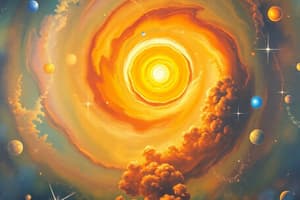Podcast
Questions and Answers
What is the main reason the Tidal Theory is no longer accepted?
What is the main reason the Tidal Theory is no longer accepted?
- It lacks evidence of gravitational pull from passing stars.
- It does not explain the formation of stars.
- Hot material from stars would expand rather than contract. (correct)
- It suggests that all planets should be gas giants.
Which planets are classified as Jovian planets?
Which planets are classified as Jovian planets?
- Earth, Venus, Mars, Mercury
- Venus, Earth, Mars, Jupiter
- Neptune, Pluto, Saturn, Earth
- Jupiter, Saturn, Uranus, Neptune (correct)
What does the Nebula represent in space terms?
What does the Nebula represent in space terms?
- A solid surface of a planet.
- A theory of constant density in the universe.
- A cloud of gas and dust that forms stars and planets. (correct)
- An oscillating universe state.
Which characteristic distinguishes the Steady State Theory from the Big Bang Theory?
Which characteristic distinguishes the Steady State Theory from the Big Bang Theory?
What best describes the Oscillating Universe Theory?
What best describes the Oscillating Universe Theory?
Which of the following was a reason the Steady State Theory was rejected?
Which of the following was a reason the Steady State Theory was rejected?
Which conceptual component is associated with the term 'nucleosynthesis'?
Which conceptual component is associated with the term 'nucleosynthesis'?
Which of the following best defines a characteristic of Jovian planets?
Which of the following best defines a characteristic of Jovian planets?
What does the Big Bang Theory suggest about the beginning of the universe?
What does the Big Bang Theory suggest about the beginning of the universe?
Which theory combines elements of both the Big Bang and Big Crunch?
Which theory combines elements of both the Big Bang and Big Crunch?
According to Hubble’s Law, how is the velocity of distant objects related to their distance from Earth?
According to Hubble’s Law, how is the velocity of distant objects related to their distance from Earth?
In the Nebular Theory, what is the first step in the formation of stars and planets?
In the Nebular Theory, what is the first step in the formation of stars and planets?
What primarily distinguishes terrestrial planets from jovian planets in the solar system formation theories?
What primarily distinguishes terrestrial planets from jovian planets in the solar system formation theories?
What does the Encounter Theory suggest about planet formation?
What does the Encounter Theory suggest about planet formation?
According to the Planetesimal Theory, how did planetesimals form?
According to the Planetesimal Theory, how did planetesimals form?
What key aspect does the Steady State Theory imply about the universe?
What key aspect does the Steady State Theory imply about the universe?
Flashcards are hidden until you start studying
Study Notes
Theories of the Universe
- Big Bang Theory: Universe originated from a singularity, an infinitely dense and hot point, akin to a black hole's core.
- Steady State Theory:
- Universe is perpetually expanding, yet keeps a constant density through continuous matter creation.
- Posits an eternal existence of the universe in its current form.
- Balance between star formation and star death.
- Oscillating Universe Theory:
- Universe undergoes a cycle of expansion and contraction until the energy from the Big Bang depletes, returning to a singularity before potentially expanding again.
- Merges concepts from both the Big Bang and Big Crunch theories.
- Hubble’s Law: Establishes that the velocity of galaxies receding from Earth correlates directly to their distance, validating the universe's expansion.
Theories of Solar System Formation
- Nebular Theory:
- Stars and planets emerge from a nebula, a cloud of gas and dust in space.
- Involves:
- Collapse of the cloud.
- Formation of a protoplanetary disk.
- Accretion of matter leading to planet formation.
- Terrestrial planets formed nearer to the sun from metallic and silicate materials, whereas Jovian planets formed farther away and are primarily gaseous.
- Encounter Theory: Planets emerged from material expelled from the sun during a close pass by another celestial body, such as a star.
- Planetesimal Theory:
- Suggests that a close encounter between the protosun and another star led to ejected material condensing into planetesimals and forming planets.
- Earth evolved from a solid state, where oceans and atmosphere developed due to volcanic activity.
- This theory is largely rejected due to contradictions regarding material behavior.
- Tidal Theory:
- Proposes stars passing close enough exerted gravitational force, causing ejection of gas and dust from the sun that formed planets.
- Denser materials created terrestrial planets near the sun, while Jovian planets derived from less dense materials.
- This theory is also not widely accepted for similar reasons as the planetesimal theory.
Key Terms
- Jovian Planets: Includes Jupiter, Saturn, Uranus, and Neptune; characterized as large, gaseous bodies without solid surfaces, located further from the sun.
- Nebula: A primordial cloud of gas and dust responsible for star and planet formation.
- Nucleosynthesis: The process by which elements, particularly hydrogen and helium, are formed in stellar environments.
Activities and Questions
- Venn Diagram Activity:
- Steady State Theory:
- Eternal existence of the universe.
- Continuous matter creation.
- Oscillating Universe Theory:
- Cycles of universe expansion and contraction.
- Blends concepts from Big Bang and Big Crunch.
- Similarities: Both theories offer explanations for the universe's existence and evolution.
- Steady State Theory:
- Challenge Questions:
- Steady State Theory: Refers to the universe's unchanging state despite ongoing expansion.
- Big Bang vs. Steady State: Both describe universal expansion but differ in density maintenance; the former relies on initial mass and the latter on continuous creation of matter.
- Universe’s Constant Density: The steady state theorizes that new matter emergence counterbalances expansion, keeping density stable.
- Unacceptability of Steady State Theory: Lacked empirical support for ongoing matter creation, overshadowed by evidence favoring the Big Bang.
- Oscillating Universe Theory: Named for its proposed cyclic nature, involving periods of expansion followed by contraction.
Studying That Suits You
Use AI to generate personalized quizzes and flashcards to suit your learning preferences.




